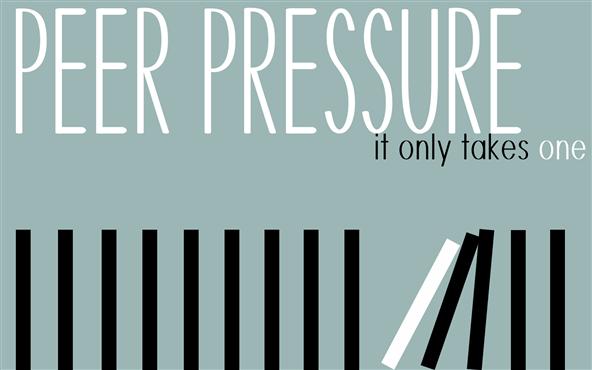Peer pressure has positive, negative effects

http://assessment-peer-pressure.weebly.com/
Peer pressure is typically viewed as negative, but it can be positive as well.
October 7, 2016
Peer pressure is giving into what other people tell you to do and straying from your original plans. People tend to give into peer pressure because the thought of being alone is scary. Peer pressure is common among all ages, because nearly everyone desires to fit in. Saying “yes” to get out of sticky situations is typically the easiest way to go.
While peer pressure is typically deemed negative, it can have positive aspects as well. While it can make someone differ from their morals and persuade them in the wrong direction, it can also lead them on a much better path than they had planned for themselves.
Peer pressure negatively affects people in four ways: logical reasoning, insults, rejection, and visual pressure. Logical reasoning is used to pressure a person by giving them rational reasons why they should or should not do something. Insults make people feel terrible for their actions they did not partake in, and persuade them to eventually do so. Rejection is pressuring someone to end a friendship or a relationship.Visual pressure is seeing multiple people acting or dressing in a certain way, which in turn makes someone want to jump on the bandwagon. This is particularly common on social media; when people see certain trends, they want to jump on board with everyone else to not feel left out.
Jumping on board, however, can be very beneficial if it is in a positive way. Peer pressure is used positively in the same four ways it is used negatively. Peers can easily pressure others with logical reasoning to get them to work hard, be compassionate, and be honest. When peers make insults, people normally jump to defend themselves, but if the insults are looked at optimistically, positive changes can occur. Sometimes when people are using the peer pressure tactic of rejection, it is for someone’s best interest, not to just tear him or her down. Peers can be persuading someone to end a relationship or a friendship because they know it is harming them even though they may not see it. Visual peer pressure is positive in many ways. Seeing others exhibit helpful, respectful, or caring characteristics can make people feel the need to do so as well, which can lead them in the right direction of life.
If a student was sitting in a classroom and overheard that there was an inappropriate party this weekend, he could use the elements of peer pressure to persuade the party goers to not attend. The student could provide the party goers with reasons why going is unwise and could use rejection to advise the party goers that hanging around people who do not have high morals is not smart. The student could offer the party goers an alternative way to spend their weekend, rather than going to the party. Instead of being rude, the student has now used peer pressure in a positive way to significantly impact others and send them on a safe route.

